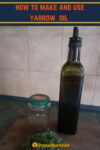Yarrow is an often overlooked and underestimated herb with potent antibacterial and anti-fungal compounds that help heal wounds, soothe bruises, and reduce inflammation.
You don’t even need to grow yarrow to benefit from its healing qualities, as this herb can be found almost anywhere, from the alpine to coastal zones.
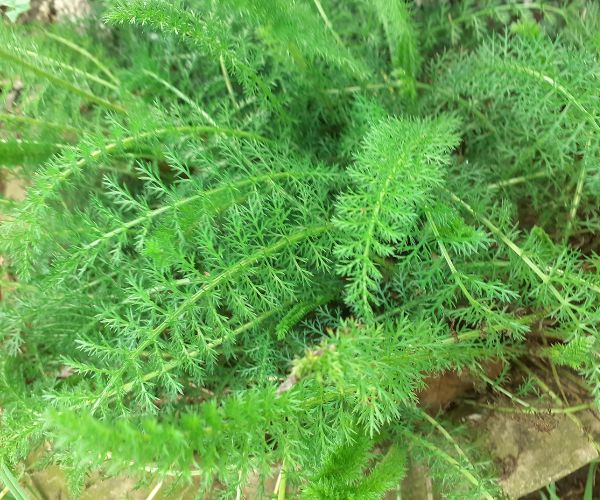
Simple to make yet highly effective, yarrow oil is a handy addition to the survivalist’s first aid kit.
Even if you can’t be bothered to make an oil, the raw leaves can be harvested and applied as a poultice to stop bleeding and treat bruises, sprains, and swellings.
A Quick Photo Tutorial on How To Make Yarrow Oil
This tutorial describes the process for making a yarrow-infused oil. Don’t confuse this with essential oil, as the methods and results are very different. To make yarrow essential oil, you need to distill the herb, but your yield will be very low.
This more straightforward method yields much more, although the final product won’t have the same potency as an essential oil. It is suitable for external use and effective at relieving bruises and swelling.
Step One: Getting Started
You need the following ingredients to make a yarrow oil infusion:
- Yarrow leaves
- Oil – I used organic olive oil, but you could also use sunflower or almond oil
You’ll also need:
- A clean glass jar with an airtight lid
- A pot of water
- Labels
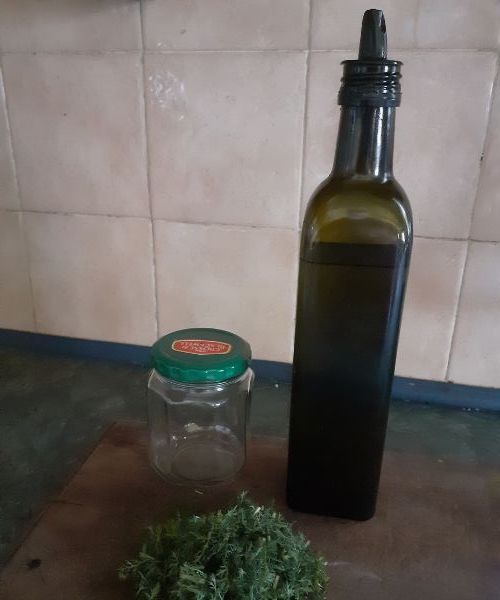
Step Two: Harvest and Process the Yarrow
Harvest the soft, feathery yarrow leaves either by hand or using scissors as I did.
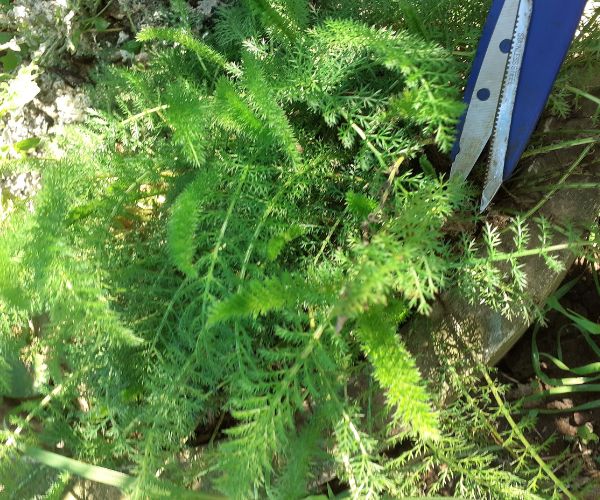
Yarrow is best picked in spring or early summer before the flowers have been pollinated.
You can make yarrow oil using either fresh or dried leaves and flowers. As my yarrow isn’t flowering yet, I used just the leaves and decided to try it fresh.
If making oil from dried herbs, you need less volume. 1 tsp of dried leaves is roughly equivalent to 1 tablespoon of fresh.
Chop or bruise the leaves to release the yarrow’s natural oils and beneficial components. I used scissors to chop the yarrow leaves, but you could also bruise them using a pestle and mortar.
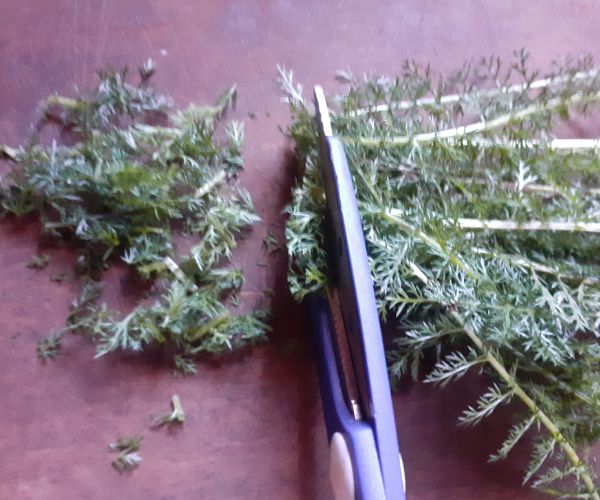
Step Three: Prepare the Oil and Container
Before you add anything to your glass jar, sterilize it with boiling water. Now you’re ready to add the leaves.
Pack the leaves loosely into the glass jar until it’s half to three-quarters full, then pour your oil over the leaves until completely covered. Seal the jar.
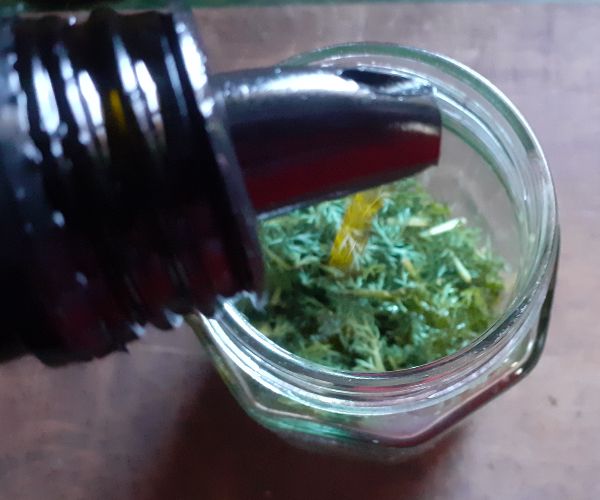
Bring a pot of water to boil on the stove, placing a plate or bowl in the bottom of the pot to stop your oil concoction from getting too hot.
Put your sealed glass jar into the saucepan and heat for five minutes. This process helps to activate the yarrow’s medicinal compounds and release them into the oil.
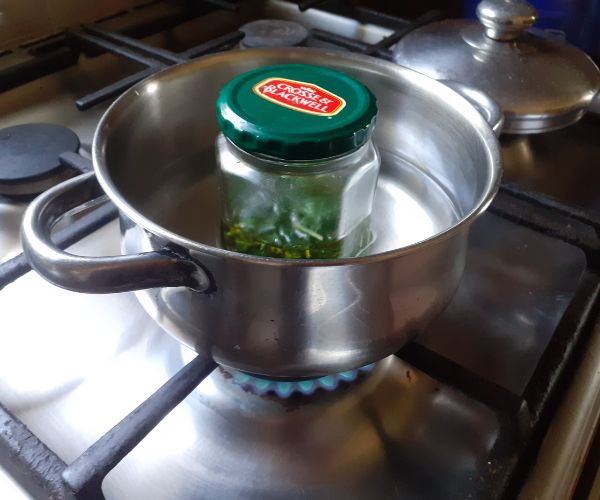
Remove the jar from the saucepan and allow it to cool.
Shake the jar to agitate the mixture further so it releases its active constituents into the oil.
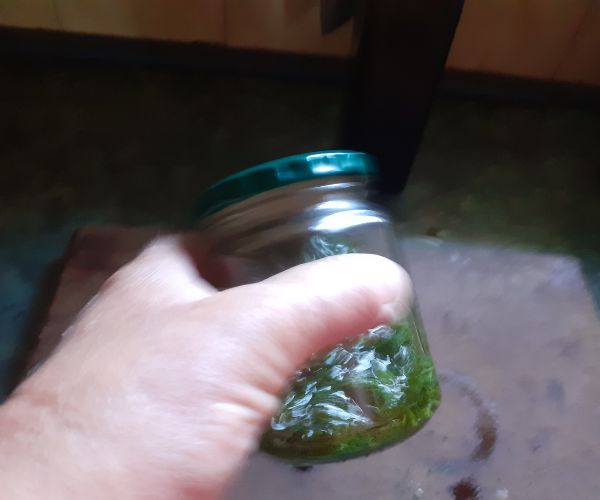
Label the jar, noting the type of herb inside and the date it was made.
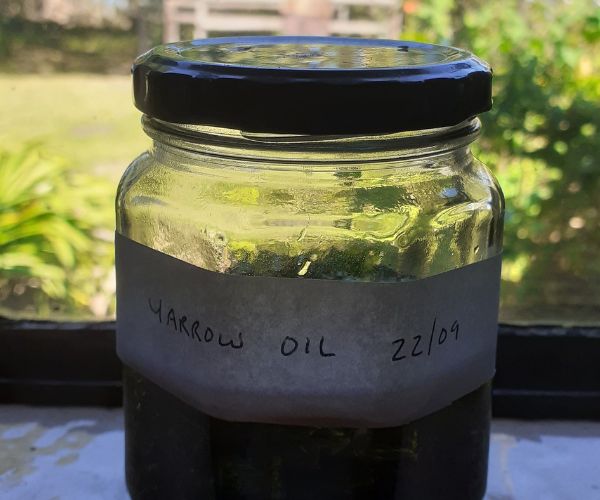
Step Four: The Finishing Touches
Leave the jar in a warm place for three to four weeks.
Once your oil is ready, strain it into a fresh, clean jar using cheesecloth. If you don’t have any cheesecloth available, you can use recycled net curtains, provided they are washed thoroughly first.
Squeeze the herbs inside the cloth or net to extract the last drops of oil before discarding the yarrow.
Your oil is now ready to use. You can also transfer the oil into smaller containers or bottles for later use.
Yarrow Oil Uses and Benefits
The yarrow plant has numerous medicinal benefits. It can treat internal and external problems, although essential oils, teas, and tinctures are more suited to internal use than infusions.
The following uses and benefits are specific to yarrow-infused oil and don’t include the potential benefits of other parts of the yarrow plant or other yarrow-based concoctions.
Reduces Inflammation
Yarrow has been used to treat inflammatory disorders for hundreds of years. A study published in 2017 also added scientific proof, concluding that yarrow has “an evident anti-inflammatory property.”
Rubbing yarrow oil into swollen joints, inflamed skin, or other swellings will help reduce the inflammation and some of the discomfort associated with it.
Relieves Skin Irritations
The same study that proved yarrow’s anti-inflammatory benefits also found a “positive impact on the skin pH and its moisture content.” These actions help to soothe skin irritated by chafing, rubbing, allergic reactions, and insect bites.
Heals Wounds
Yarrow oil heals and cleans wounds. It has antibacterial properties that make it an effective disinfectant. It is also an astringent and, as such, helps reduce irritation “through a sort of numbing action.” Astringents also create a barrier against infection, thereby promoting healing.
Yarrow oil is believed to stimulate the production of fibroblasts, cells that help form connective tissue. This helps the cells regenerate quicker, facilitating wound healing.
Improves Blood Circulation
I first used yarrow for medicinal purposes on my dog. My husband had been chopping down alien vegetation when the machete he was using flew out of his hand. Narrowly missing my head, it bounced once on the ground before catching the dog on the nose.
The wound wasn’t deep, but because of its location, it bled heavily. I grabbed a handful of yarrow leaves and pressed them onto the wound. While the dog wasn’t very impressed, after five minutes or so, the bleeding stopped.
Yarrow is widely used as an anticoagulant, but strangely enough, it also promotes blood circulation. Massaged into joints, it can improve circulation and help prevent the accumulation of uric acid. As a result, it can help relieve arthritis and rheumatism as well.
Heals Varicose Veins
Yarrow relaxes the peripheral blood vessels and improves the tone of the vein walls, which can help alleviate varicose veins. Massaging the oil into the affected areas will relieve the inflammation associated with varicose veins.
Disinfectants Wounds
Superficial scratches and scrapes can become life-threatening if they get infected. Dab a little yarrow oil onto minor wounds; its antibacterial components will keep infection at bay.
Yarrow has been used for this purpose since the Trojan War when, according to Greek mythology, it was used “as an anesthetic, disinfectant and blood-clotting agent.”
Read more about antiseptic plants.
Treats Hemorrhoids
Yarrow oil is a topical treatment for sore or bleeding hemorrhoids. It will stop the bleeding, relieve pain and inflammation, and promote healing.
Yarrow oil can also improve skin conditions, prevent acne, and stimulate hair growth.
How To Use Yarrow Oil
Essential oils can be taken internally, but oil infusions like this one are more suited to external use. The three most common ways of using yarrow oil are:
- For sore and swollen joints and muscles, massage the oil into the affected area, repeating as necessary.
- To treat wounds, gently rub a little yarrow oil into the clean wound twice daily.
- Apply the oil yarrow directly to skin irritations, including allergic reactions, rashes, insect bites, and eczema
Is Essential Yarrow Oil Better than an Infusion?
Essential yarrow oil can be used internally and externally, making it more versatile than a homemade infusion. Taken internally, yarrow oil can treat inflammation, reduce anxiety, aid digestion, and prevent colds and flu.
Essential yarrow oil may also:
- Support the immune system
- Stimulate menstruation
- Relieve insomnia
- Alleviate hay fever
This yarrow oil infusion is more suited to external, topical applications, limiting its usefulness.
While I doubt any harm would come to you if you did decide to use the infusion internally, I’m not sure it’s potent enough to have a beneficial effect.
Possible Side Effects of Using Yarrow Oil
Yarrow oil can cause minor skin irritation when applied topically, but beyond that, it’s completely safe to use.
Taken internally, yarrow oil carries some risk, although the worst most people experience is a little drowsiness and more frequent urination.
Although yarrow contains a chemical known as thujone, which is “poisonous in large doses,” WebMD says it’s safe to take in doses of up to 500 mg a day for a maximum of 12 months.
Conclusion
Yarrow oil is simple to make, and because it has antibacterial qualities that can protect wounds against infection, it could save your life.
Not only is yarrow oil antibacterial, but it also promotes wound healing, reduces inflammation, and treats skin irritations.
If you’re stuck in the wilderness without a first aid kit, you can use raw yarrow leaves to stop bleeding and kickstart the healing process.
Also see
